The Definitive Guide to Sales Enablement
Updated July 2023
In order to increase buyer engagement and bolster revenue, sales reps need the right content, training, and materials at their disposal to peak buyers interest and perform their responsibilities at the highest level. In this guide, you’ll learn the basics of sales enablement strategy as well as best practices, practical examples, and how to build an unstoppable sales team. Consider this your go-to resource as you design and deploy an effective sales enablement strategy for your business.
Here’s a sneak peek at what this portion of the guide will cover:
- What is Sales Enablement?
- Defining Principles of Sales Enablement
- Sales Enablement Strategy
- Why is Sales Enablement Important?
- Who Owns Sales Enablement?
- What is a Sales Enablement Tool?
- How is Sales Enablement Practiced?
- Sales Enablement Best Practices
What Is Sales Enablement?
Sales enablement is the strategic, ongoing process of equipping sales teams with the content, guidance, and training they need to successfully engage buyers. Effective sales enablement requires marketing and sales to work harmoniously both internally and externally to increase revenue, shorten the sales cycle, and improve conversion rates along with forecast accuracy.
More often than not, sales enablement is a very manual, time-consuming process that bogs down performance. With the right platform, people, processes, and technology, companies can work to create a more dynamic and proactive sales team. The byproduct: better sales performance and a happier, more successful sales organization.
Placing a focus on sales enablement makes sales teams more effective by…
- Connecting sellers to relevant content
- Providing flexible ways to present content
- Delivering real-time visibility into customer engagement
- Applying advanced analytics to optimize pitches
- Equipping sellers with training and guidance
- Measuring all of the above and mapping against bottom-line results
3 Defining Principles of Sales Enablement
Principle 1: Commit to a Sales Enablement Process
Establishing a process for sales enablement provides the necessary framework to begin coherently organizing, finding, sharing, customizing, and analyzing content. This process requires input from multiple teams, clear expectations, and a plan to execute on sales enablement goals.
Establish your sales enablement process with Highspot today.
Principle 2: Know and Involve Your Sales Team
Think of the sales process as a funnel with four basic stages. The upper half, comprising the “Awareness” and “Consideration” stages, is owned by marketing and is focused on generating interest in the company’s products and services.
The lower half is primarily owned by sales and is focused on closing deals and generating revenue. Sales enablement software is the new key player in transforming this part of the sales cycle and equips sales reps with the tools, skills, and assets they need to effectively engage with buyers and drive maximum revenue for the company.
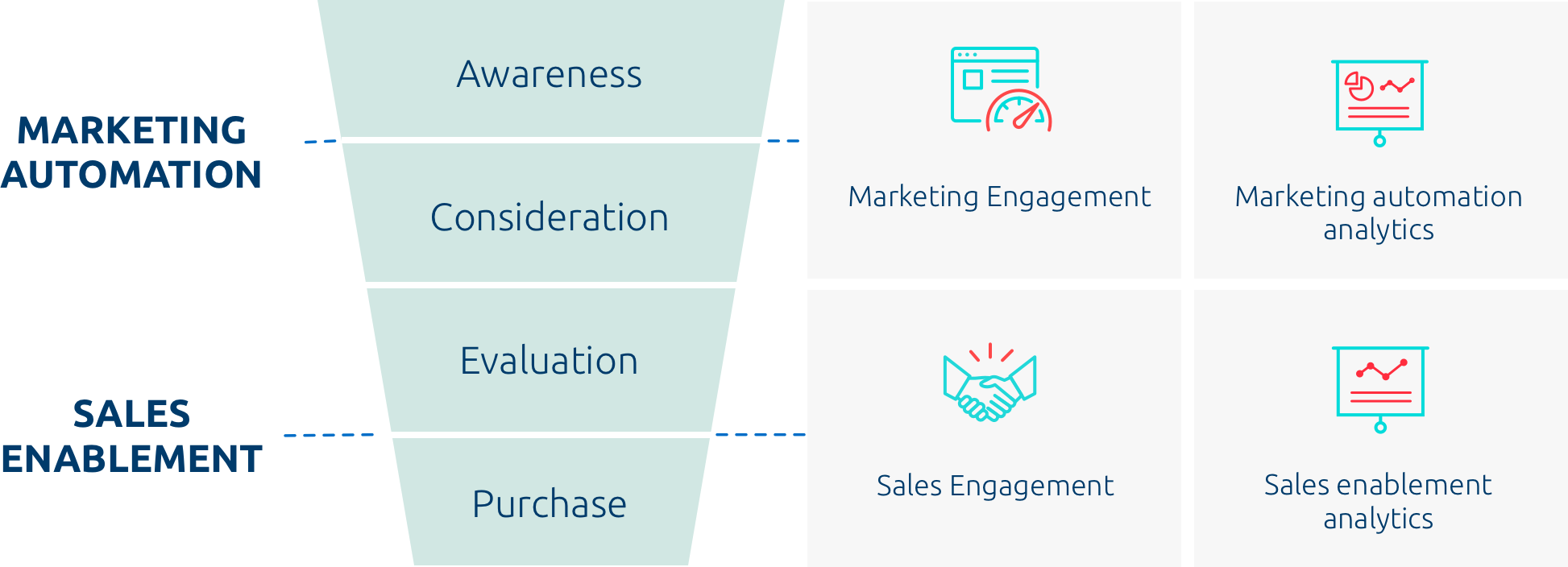
Keeping the sales team’s requirements top-of-mind throughout every aspect of content management, publishing, and engagement is essential to getting the most out of your sales enablement investments.
Principle 3: Engagement Equals Revenue
Sales enablement improves performance by helping reps consistently engage with prospects and customers throughout the buying process.
Every salesperson knows that engagement = opportunity. Without strong processes, focus, and intentions, the benefits of sales enablement technologies are inherently limited. By thinking strategically and applying best practices in the critical areas of sales enablement content management, sales coaching / training, playbooks, and sales operations, sales enablement can drive astounding results and transform sales effectiveness.
We’ve summarized some final thoughts on sales enablement in the videos below.



IN SHORT: Sales enablement helps reps do their jobs better by giving them the training and tools they need to close deals. To create a winning sales enablement strategy, be sure to prioritize processes, involve your sales teams, and increase content engagement.
Sales Enablement Strategy
Sales enablement strategy refers to the approach your business takes to provide sales with the resources they need to effectively sell. Here are 9 guidelines to follow when crafting your sales enablement strategy.
- Evaluate your current marketing and sales process: Identify where there’s opportunity for improvement, where you might be able to expand, or where you can afford to scale back. Document all within a sales enablement charter so that you can have a concrete roadmap to move your company forward.
- Define roles and responsibilities: Once your charter is complete, your next move should be to define the roles and responsibilities for each enablement stakeholder (i.e. leadership, management, and operations).
- Understand your target market: Get to know your ideal customers as you build your sales enablement strategy. This will help lay the groundwork for much of your sales enablement program.
- Map content to the customer journey: After you’ve developed your ideal buyer personas, make sure to outline each profile’s respective buyer journey. These outlines will help with the content management portion of your enablement strategy, empowering you and your team to match existing content (i.e. case studies) to specific consumer stages and their corresponding pain points.
- Get to know your top performers: As you prepare your sales enablement strategy for launch, take some time to really familiarize yourself with your sellers. Observe their day-to-day operations. Meet with reps directly whenever you can. Chat with sales managers and ask for their input on who’s thriving and who’s lagging behind.
- Provide sales onboarding, training programs, and support: Combine everything from customized training paths and templates to comprehensive content recommendations and conversational roleplay. In addition, your strategy should always remain flexible, providing reps with all the intel and materials necessary to stay on top of market trends.
- Establish metrics to measure success: Once your methods of operation start lining up and you’re ready to give your sales enablement strategy the green light, you should round out preparations by: 1. Establishing kpi metrics of success and 2. Identifying parameters for “good” performance.
- Select the right sales enablement tool: When evaluating sales enablement tools, be on the lookout for platforms that can streamline communication, have integration with your current stack, automation for tedious tasks, and surface content for sellers at the right time.
- Implement, optimize, repeat: Whatever challenges you face, always be ready to amend your policies and initiatives as needed.
Why Is Sales Enablement Important?
When it comes down to it, sales enablement is important because it aligns your sales and marketing teams and provides salespeople with the information, content, and tools to help them sell more effectively and efficiently. Let’s take a closer look at why sales enablement is important through these five benefits.
Sales Enablement Helps Scale Success for Sales and Beyond
By equipping your sales reps with proven sales enablement tools, the business becomes less reliant on traditional top performers to carry the load. This support empowers lower or middle-tier performers to reach their full potential.
Looking outside of the sales force, sales enablement benefits multiple parties within the business. Every function that deals with the buyer (sales engineering, customer success, and support teams) requires content and training that align with your overarching sales strategy.
Sales Enablement Creates Stronger Sales Data
Many of the tools geared towards selling B2B products specialize in data — collecting it, organizing it, and activating it for the sales team. Insights around buyer preferences, pain points, and personas help sellers reach prospects with a more tailored approach.
Sales Enablement Increases Deal Velocity
With better data and tools at their disposal, sales reps tend to have quicker access to what they need, and as a result are more “sales ready” leading to more fruitful conversations, a smoother buying process, and a better win rate.
Sales Enablement Creates Better Alignment with Marketing
Sales reps are more successful when they can provide prospects and leads with the right materials and messaging at the right time. As such, strengthening the relationship and collaboration between sales and marketing is a major aspect of sales enablement.
Sales Enablement Improves Company Reputation
Each time a rep interacts with an outside party, they’re representing the business and making a lasting impression on its behalf. When salespeople are informed, responsive, and helpful, it reflects well on their organization and improves the customer experience.
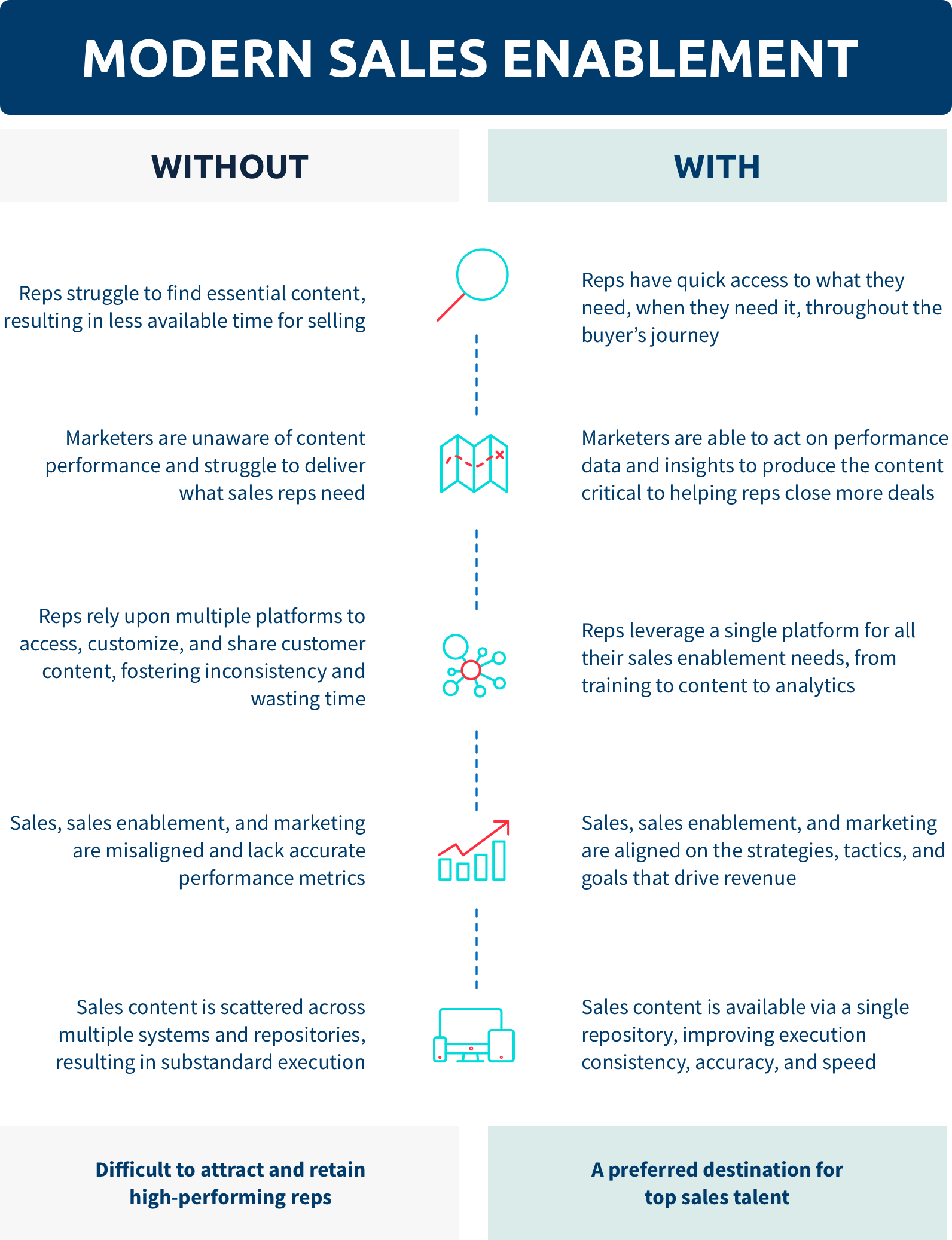
IN SHORT: Sales enablement is increasingly becoming a necessity for successful teams as the sales landscape adapts to new technology. One of the most important aspects of enablement is content engagement and overall alignment, and a well-executed enablement strategy can help meet that goal.
Resource: Put an End to Sales Content Chaos
Who Owns Sales Enablement?
When it comes to sales enablement, who’s designing strategies and coaching reps through the sales process? Clear definitions of ownership and accountabilities form the foundation of every successful sales enablement solution. Sales enablement leaders must hold themselves accountable for successfully implementing a platform capable of delivering the content management, customer engagement, analytics, and sales training content their organization needs. Their counterparts in sales must commit to the processes and technology that make the system work for them. And marketing must be on the hook for achieving high engagement and better-than-benchmark ROI.
The table below illustrates these responsibilities:
| Marketing | Sales Enablement | Sales |
| Develop effective content as measured by engagement and impact on revenue. | Drive success in content management, customer engagement, performance analytics, and sales training content. | Commit to infuse sales enablement processes and technology in day-to-day business. |
Of course, sales enablement roles and responsibilities will vary based on the size of company, sales and distribution model, and markets served.
If you’re just getting started with defining sales enablement ownership, you might find it helpful to use the RACI framework. RACI is a common approach toward allocating team roles, responsibilities, and expectations.
- Responsible: Sales enablement lead
- Accountable: VP of Sales Enablement or VP of Marketing
- Consulted: VP of Sales, content creators, sales operations
- Informed: The broader sales enablement team, sales reps, and other senior marketers
With the RACI framework, roles and expectations for executive, sales, and marketing stakeholders become clear. This alignment and shared understanding then supports the cross-team collaboration needed to help sales enablement succeed.
What Is a Sales Enablement Manager?
A sales enablement manager supports the sales team by building sales content, sharing enablement best practices, and developing training. Often, the role also manages technology such as the content management system (CMS), customer relationship management (CRM) system, or sales enablement platform.
Generally, sales enablement managers will:
- Know where content is stored for marketing and sales
- Bridge the gap between the marketing and sales function
- Understand the structure in which content is organized including the current “content map”
- Proactively implement changes or new process, tools, strategy, etc. for sales
- Have expertise in the sales team’s CRM knowledge and usage
- Depend on sales productivity and performance measurements and analytics
- Improve learning styles, sales strategies, design, implementation, and measurement of methods and approaches
- Provide feedback from sales to marketing
- Work with marketing and sales and identify decision makers, blockers, etc.
The role will vary at different companies and across industries. They may report to sales, marketing, or sit on their own separate sales enablement team. Regardless of these differences, sales enablement managers generally possess the common traits listed above and all share the same goal of enabling the sales team to sell more effectively.
IN SHORT: The sales enablement team must work closely with marketing and sales leaders to ensure the enablement strategy is executed to maximize results. A sales enablement manager who is equipped with content knowledge, a training strategy, and overall best practices and processes is a critical enablement role.
Sales Enablement vs Sales Operations
Companies that have sales operations as well as marketing and sales teams have additional work to do in defining sales enablement ownership. In these organizations, it is important to define roles, responsibilities, and collaboration opportunities clearly in order to avoid overlap and duplicative work across sales operations and sales enablement teams.
At a high level, both sales enablement and sales operations teams work to increase the effectiveness and efficiency of the sales team. There are practical differences between the two roles, however. We’ve outlined them below:
| Sales Operations | Sales Enablement |
| Sales rep operations: Territory planning, deal routing, account assignment, team design | Sales training, including content, process, and training events (SKOs) |
| Sales administration: Proposal and contract management, contract governance | Content planning, mapping, management, and analysis |
| Compensation optimization and administration | Sales communication |
| Forecasting reporting and accuracy maintenance | Customer engagement tools, processes, and analysis |
| Systems and data management: CRM, CPQ, SPM analysis related to the above | Increasing sales efficiency through process, tools, training, technology, and performance analysis related to the above |
In general, sales enablement focuses on activities earlier in the buying cycle and sales operations on later-stage essentials.

What Is a Sales Enablement Tool?
A sales enablement tool is a platform or system that provides visibility across sales content, training, and coaching lifecycle. With content management, playbooks, sales training, onboarding, coaching, and end-to-end analytics built within one sales enablement tool, it closes the loop between marketing, sales, and potential customers. Therefore, making it easier for you to optimize strategies for revenue growth and easier for salespeople to engage buyers and close deals.
Sales enablement platforms did not always take the form that they do today. It took several iterations for the tools to evolve from centralized sales portals, to end-to-end sales solutions, and finally into the closed-loop system of today’s modern sales enablement platforms.
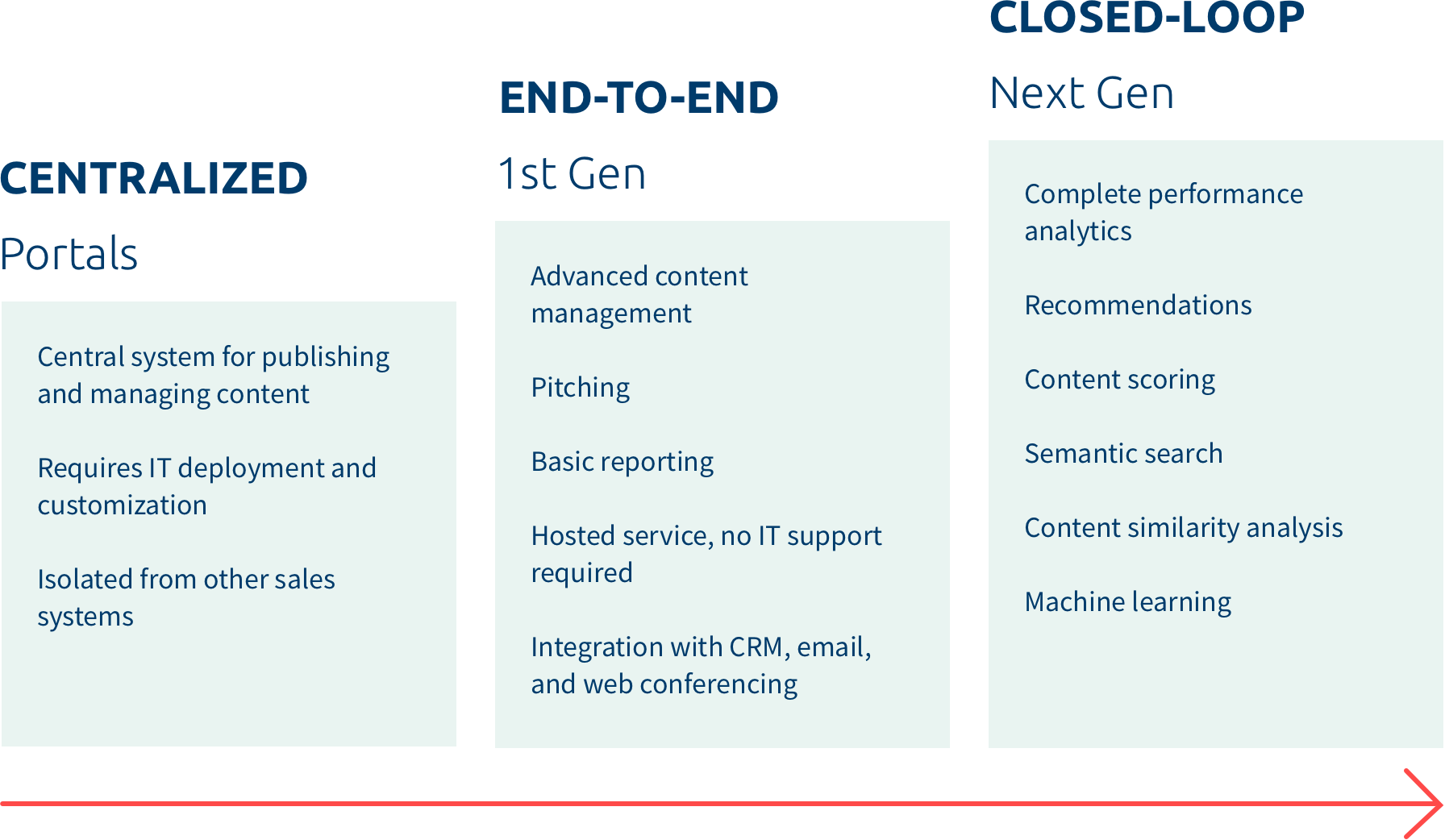
Modern sales enablement platforms take the idea of end-to-end much farther. For the first time, one system provides all the content, contextual guidance, cross-team workflows, and training sales reps need to build stronger connections and meet sales goals faster.
Analytics answers all of the key business questions about the effectiveness of the content and sales performance – showing which assets are available, whether they are found by the sales team, how the content is used, which items are sent to customers, and how customers engage with them, allowing reps to make more data-driven decisions. The system connects content usage with the performance of every deal, tracking which items are touched by every customer and when.
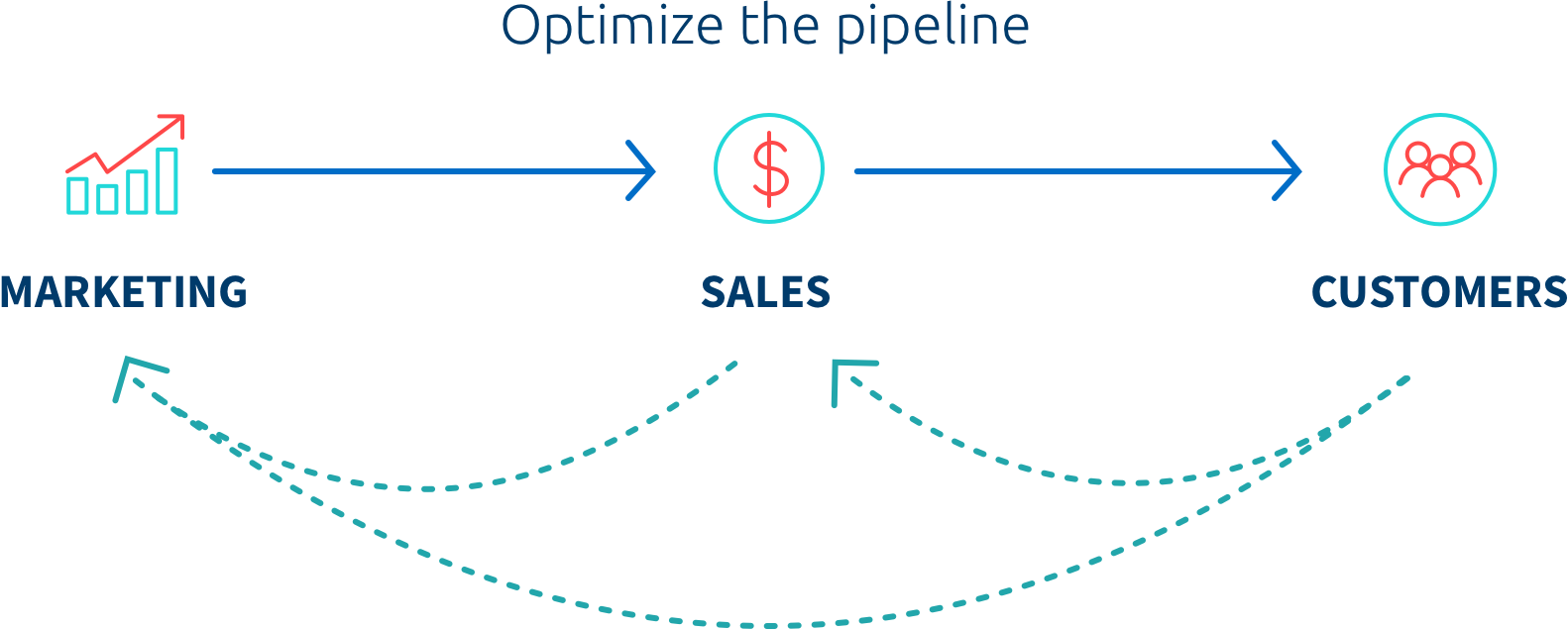
IN SHORT: Modern sales enablement tools will facilitate content and sales strategy alignment across marketing, sales, and sales enablement teams.
Resource: The Essential Revenue Tech Stack
Characteristics of a Modern Sales Enablement Tool
Search That Works
The reason that search engines like Google are able to work so well is that they analyze billions of web pages and the results of billions of searches to see which results are the most likely to be interesting to each individual user. Those same techniques let reps quickly find the content they need across all of the information in the company. Instead of emailing a couple of friends and hoping somebody knows where to find a relevant document, reps can search for what they need and find it immediately.
Scoring and Recommendations
The system can score and recommend content based on what has been successfully used in the past. If a rep is selling to a manufacturing enterprise in Germany and is in the discovery stage of the sales cycle, they can access the content that has been successfully used for deals like that in the past. Every characteristic of the deal is analyzed – the region, the industry, the company size, the stage of the sales cycle – to find the content that has performed the best. Based on what was used in deals that closed, and whether that content had a measurable impact on the likelihood and the velocity of the deal moving forward, the system shows the rep which items are the most likely to be effective for this customer.
Similarity Analysis
At most companies, much of the content that reaches the customer through the sales team has been modified and repackaged. Sellers customize decks in the format most relevant to the customers they are engaged with, remixing slides from existing presentations and adding unique content relevant to the deal in play.
In the past, changing a single word in a presentation created a new file that looked entirely different from the original. If the analytics system can’t track the original content as it is modified and repackaged, most of the data about customer engagement will be lost. Data science uncovers those relationships and measures the true usage and performance statistics for the content that your company is creating.
Sales Guidance
By giving reps sales plays and playbooks, you are handing them a guide for sales success. Sales enablement tools have the ability to organize critical context and content for any selling scenario: launching a new product, reaching target buyer personas on email vs social media, rolling out a new sales methodology, or even addressing competition and common objections.
Reinforce Knowledge Retention
The right training and coaching transform good sales professionals into great ones. Effective sales training means arming reps with essential sales techniques and transforming new knowledge into daily habits and winning behaviors. Sales enablement platforms enable you to build effective sales training programs and certify sales reps on key knowledge and skills, then—reinforce that knowledge through the same platform. From there, sales managers can efficiently provide high-value feedback, assess and hone skills, and improve performance—transforming struggling sellers into top performers.
Resource: The Evolution of Sales Readiness
How Is Sales Enablement Practiced?
The role of a sales enablement pro has never been more strategic or demanding. From orchestrating sales content to tracking engagement and pivoting focus at a moment’s notice, it’s a position requiring a unique combination of flexibility, empathy, and strategic thinking. There are a number of sales enablement best practices that can guide your efforts, but these are the seven steps we recommend you take when you’re getting started with sales enablement:
There are a number of sales enablement best practices that can guide your efforts, but these are the seven steps we recommend you take when you’re getting started with sales enablement:
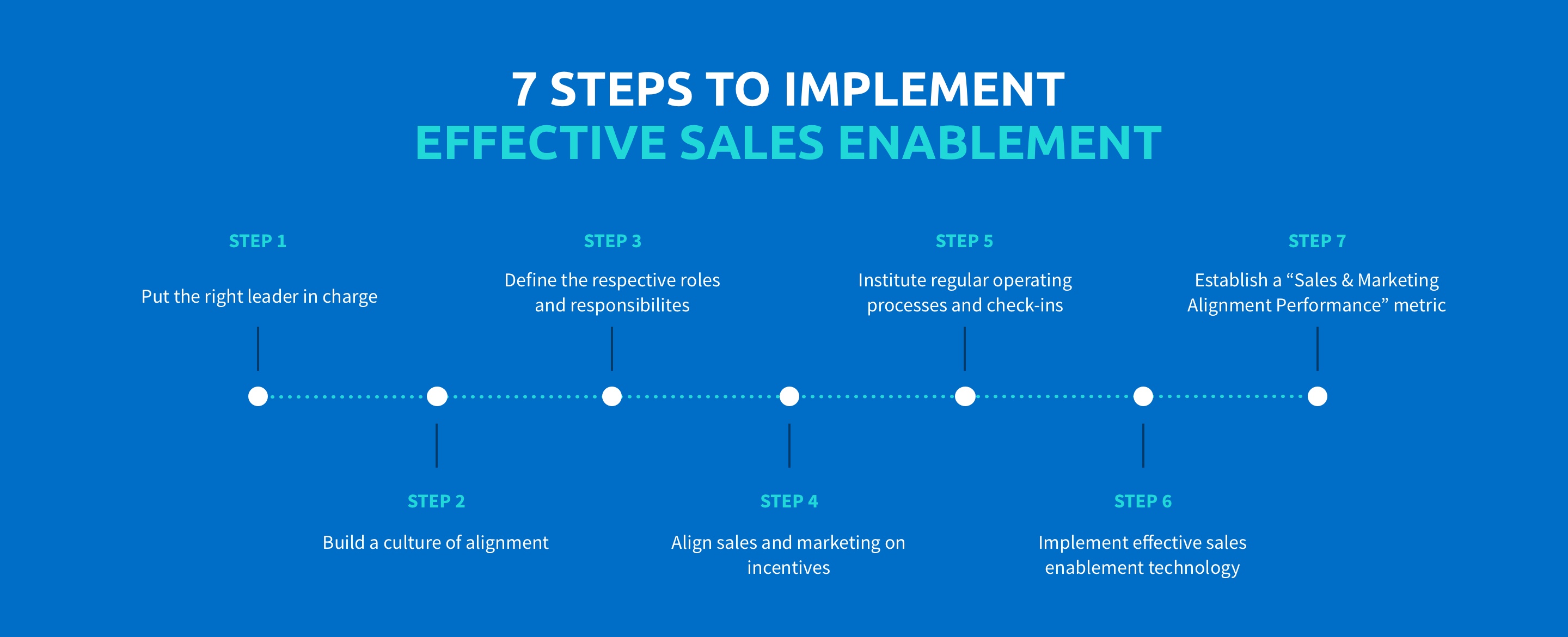
As you take these steps toward implementing sales enablement at your company, keep these main takeaways in mind:
- Build a strong sales enablement foundation. Know your audience, your charter, your priorities, your team, and your resources — and execute unrelentingly.
- Focus on the gaps contributing to your biggest challenges. Close them with data-driven thinking, document your learnings, and share your perspective across teams. As you do, you’ll elevate your accountability and demonstrate the type of sales enablement leadership every organization needs.
- Use technology as a catalyst for sales enablement success. It can help accomplish amazing results, but only if the platform you select and the process you follow align with what your business needs most.
At most companies, sales enablement often evolves in stages, starting with reactive support and ending as a fully optimized solution. This mirrors the advancement from legacy to modern sales enablement technology that must happen as a company’s sales enablement requirements grow. The image below illustrates the defining characteristics of each stage:
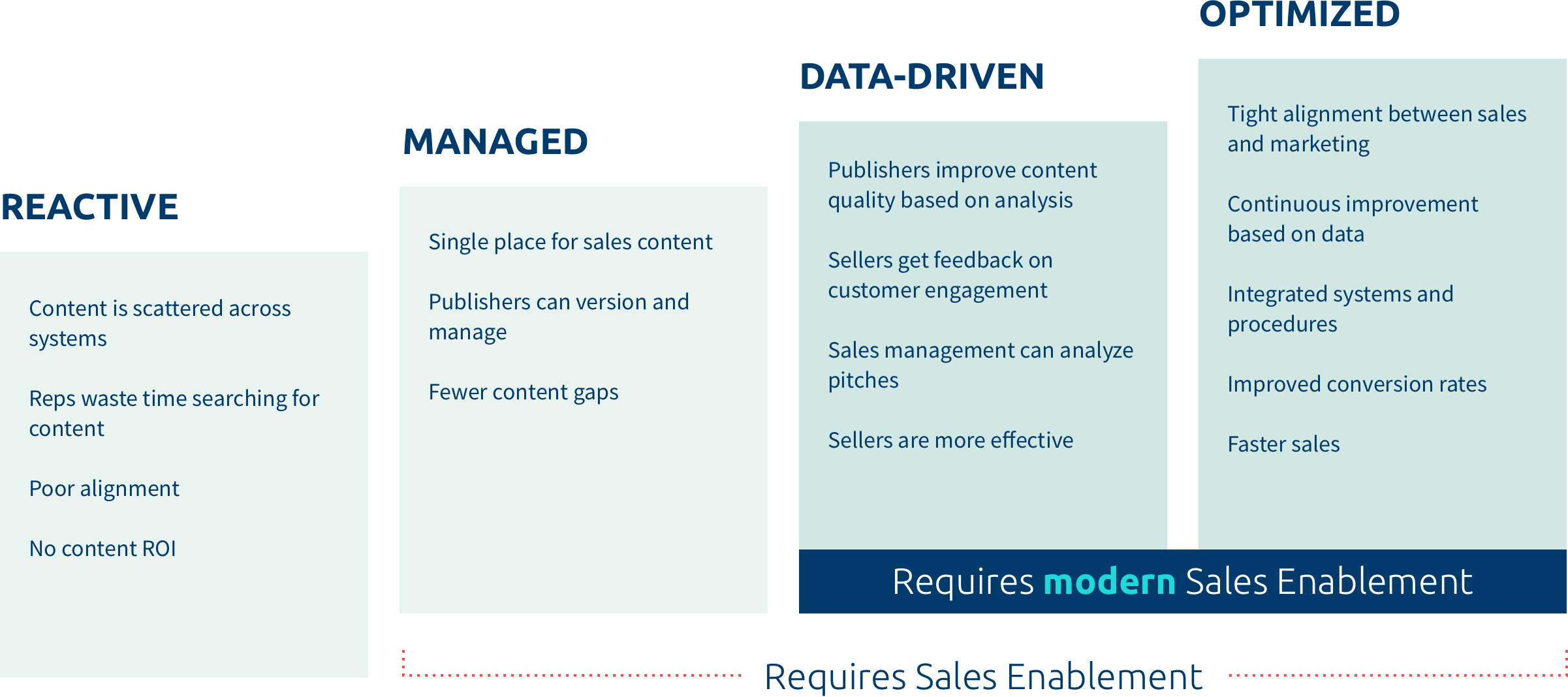
IN SHORT: Sales enablement requires careful planning and strategizing. It usually follows a maturation process, with data-drive and optimized enablement marking the end of the maturation process.
Resource: Increase sales productivity (PDF download)
Sales Enablement Best Practices
Here is a quick rundown of the key sales enablement best practices all teams should know:
- Embrace new selling strategies — this means making sales training and onboarding a bigger priority.
- Gain an understanding of what the sales team needs to better address customer questions and pain points.
- Bring marketing and sales together to develop content.
- Create relevant content that combines marketing analytics with reps’ first-hand experience with sales conversations.
- Make technology investments a priority — today’s sales process depends on access to data, automated tasks, and a connected view of every interaction with customers and leads.
Resources: What Good Looks Like—The Essential Sales Enablement Playbook